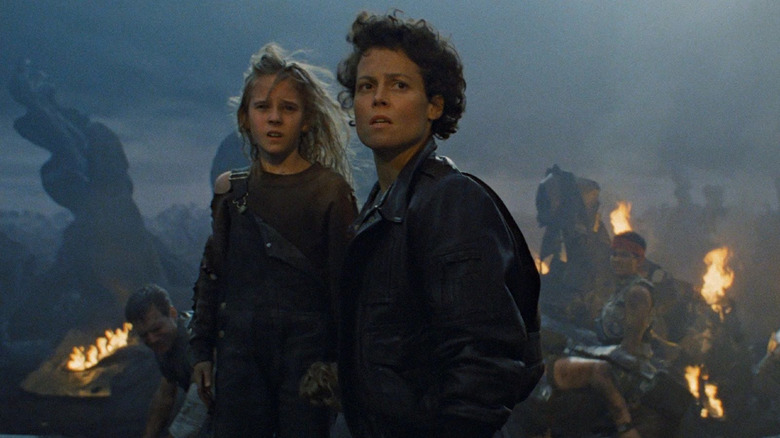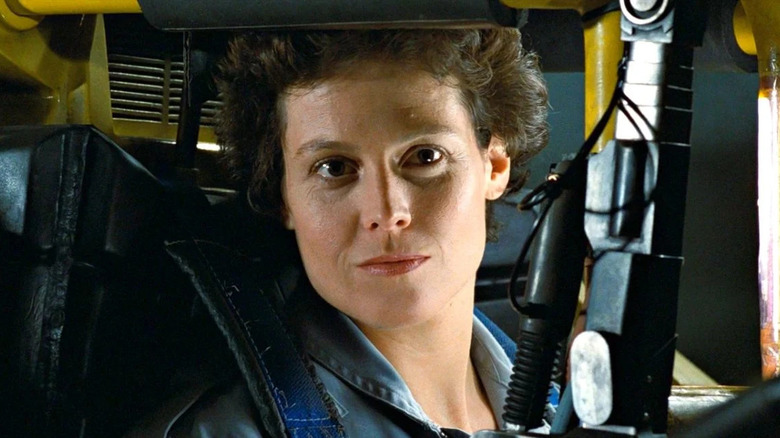The Studio Didn't Think Aliens Needed Sigourney Weaver
Ellen Ripley, a mother, xenomorph slayer and icon across galaxies, was a role originally coded as male. Dame Helen Mirren, who also read for the part in Ridley Scott's 1979 sci-fi horror hit "Alien," alluded to as much to Vulture ("...when Ripley said or did things, you had no idea whether Ripley was a man or a woman."). But the 29-year-old Sigourney Weaver's casting married her 5-foot-11 stature and steely presence to the part, which still contained traces of the action hero as known at the time.
Ian Nathan's book "Alien Vault: The Definitive Story of the Making of the Film" covers Weaver's casting. Late to her New York audition because she entered the wrong building, Weaver showed up in "thigh-high hooker boots" and a handful of theater credits to her name (on top of an education at Stanford and then Yale Drama School). She bore little resemblance to Ripley, at that point an inexperienced but steadfast warrant officer. Weaver's connection to the character was threadbare at first, and she was less than impressed with the script. She told The Guardian:
"I didn't want to do it. It was sci-fi, and I was a total snob. I wanted to do Mike Nichols, Woody Allen, Shakespeare."
Nathan suggests it's that resistance to conventional "mass-market energies" that made her perfect for the role of Ripley, a leader whose staunch competence doesn't win her popularity contests, but when she's right, she's right. At the behest of Fox CEO Alan Ladd Jr. (who greenlit "Star Wars"), a screen test was set up for Weaver on the Shepperton Studios-constructed Nostromo bridge. Check it out below:
Naturally, she got the part, earning a $30K paycheck and launching her career into orbit. The One Who Lived beyond "Alien" should have been a shoe-in for the sequel, but it wasn't so easy.
No Weaver, no Ripley, no movie
When the opportunity came to revisit the "Alien" story several years later, this time with "Terminator" director James Cameron at the helm, the last survivor of the Nostromo seemed like a natural focal point to launch the sequel from, but Fox had reservations. Cameron had departures in mind — expanding from one alien to swarms of them, including a formidable hive queen, for example — but the tenacious Ripley, now a lieutenant, and the actor who played her remained a hard constant for the filmmakers. Cameron confirmed to Jean-Marc Lofficier that the film's beginning, with Ripley being recruited to investigate a possibly lost colony of terraformers on an exomoon, was "a given." Although Sigourney Weaver had not yet boarded the project, producer Gale Ann Hurd explained Ripley was a north star for the developing story, and there's no Ripley without Weaver. Cameron elaborates to Lofficier:
"I was asked to write a story based on Ripley. Later on it turned out that everybody but us thought that the film could be made without Sigourney Weaver, which completely blew my mind, and was absolutely out of the question for us. So, as far as we were concerned, we started with Ripley from the end of the last film, and it was her story. We, fortunately, were able to overcome these obstacles in the minds of the other people involved. We had to fight very hard for Sigourney to be in the picture, which to me was crazy ..."
Without Weaver, Cameron argues, it's an entirely different movie. A 1987 Best Actress Oscar nomination for Weaver, along with further sequels centered on her character (or a variation thereof) would support his sentiments. By the time she did "Alien: Resurrection" in 1997, Weaver would take $11 million to the bank.

